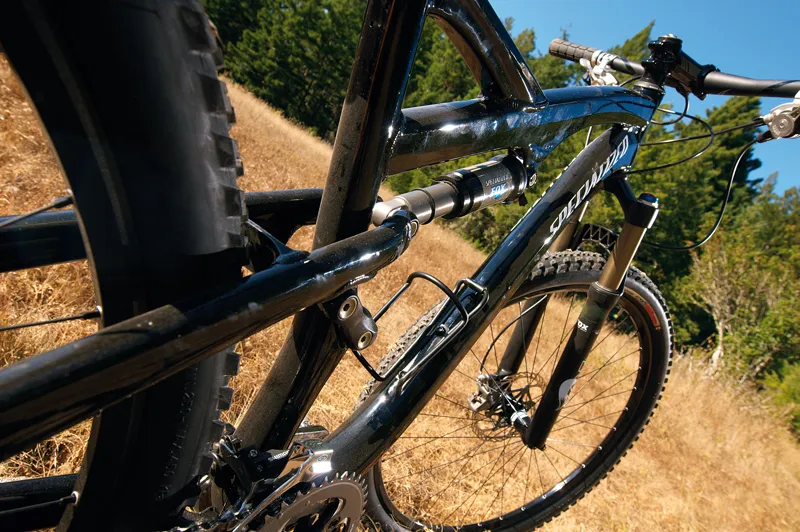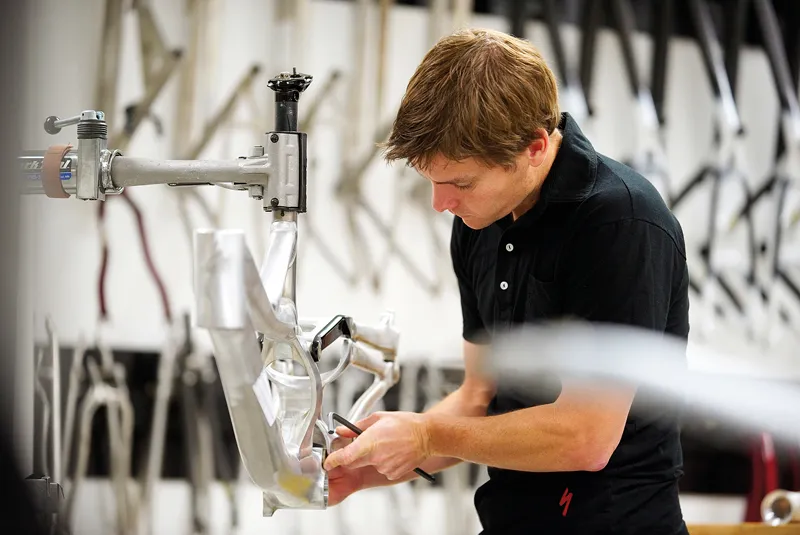29ers – mountain bikes with larger 29in wheels instead of the standard 26in size – have taken off in a big way in the US but they're only just starting to make inroads into the UK market.
We grabbed a few minutes with Brandon Sloan – a one-man encyclopaedia of mountain bike engineering and riding trends, who heads Specialized's bike research and development team – to find out why he thinks big-wheelers are the future, at least for cross-country and some trail riders.
BikeRadar: What’s new in the 2011 Specialized range?
BS: This was probably the biggest development year since I’ve been here – and I’ve been here 10 years. We did the all-new Epic in 26in and 29er versions, the same with the Camber, built an all-new carbon hardtail – again, in 26in and 29er versions – plus the new Demo, and [made] major revisions to the SX Trail.
You clearly see a real shift towards 29er bikes, then…
Absolutely. We’re not the first, but once we had the opportunity to get the geometry dialled in and get the weights down, the bikes weren’t piggy and sluggish like they used to be. The 29er setup makes the ride quality [on a hardtail] so much better than on a 26er. And on the [full-suss] Epic as well – same deal, it makes the bike way more capable. The weight penalty isn’t nearly as big [as it used to be]; in fact, the 2011 Epic 29er is lighter than last year’s standard Epic.
Are there any particular design difficulties to overcome when you’re building a 29er version of an existing 26in model?
That’s a good question. On the 29er side of things, there’s still trouble fitting the wheels in, especially with our geometry – low bottom brackets, short chainstays, roomy top tubes and relatively slack angles… The biggest problem is the chainstays. These are really short, because we like a nice nimble bike, and putting the big wheel in there makes it difficult to get the travel we need with the tyre and chainring clearance clearances and the stiffness that we need. It’s tight.
That’s quite a list. Is it worth it?
I think so. I think it’s worth it on the Epics and the hardtails. The hardtails are a lot easier, because we don’t have to worry about the wheels moving [due to suspension travel]. The Epics and Stumpy FSRs are the problem – more travel, more headaches to get those short chainstays sorted out.
Are we going to see an interim period where platforms are available as both 26 and 29ers?
Having said that 29er is the best option for cross-country, when you get into the area of the Camber and the Stumpy – longer-travel trail riding – people are still looking for that right balance of weight, rideability and flickability. I ride a 29er Epic and 26in Stumpy. Those categories aren’t as clear for us. Cross-country race is easy – 29er is the way to go. Cross-country trail… Not so obvious.

The beloved Stumpjumper is getting Spesh’s 29in treatment for 2011
So there’s this crossover area in the trail riding market that already offers a range of travel options. How are riders going to cope with having to make a wheel size decision as well?
We, as manufacturers, have the luxury of trialling bikes back to back, so we can make an informed choice. But for the consumer, it’s a lot harder and that’s where we’re trying to get our sales groups to make test bikes available to our dealers. The key is you’ve got to try it. If you don’t try it, you’ll never know. You have to feel it on your own trails.
What about spare parts availability?
It’s easier for us, because we make our own tyres, and we have rims made to our specification for our wheels, so some of the major concerns when 29ers first came out aren’t as much of an issue now.
Can you summarise the benefits of 29ers for riders?
The main benefit is it’s a different geometry. What makes the bike feel different [in comparison to 26in bikes] is the bottom bracket drop relative to the axles. It’s a greater bottom bracket drop for the same BB height, so when you ride a 29er for the first time, you have that feeling of riding ‘inside’ the bike. The bigger wheels have a different angle of attack and tend to roll up and over trail obstacles a lot easier than a 26in wheel: they get hung up less. Also, at the lower levels – for the Hardrock and Rockhopper riders – the geometry is a lot more stable, which makes it better for beginners.
So what convinced Specialized to jump onto the big-wheeler bandwagon so enthusiastically?
The 29er push came from riders. We definitely weren’t the first, although we like to think we’re getting it right now. But it was market feedback from riders and dealers saying to us we should check it out. We built a load of test mules, checking the geometry. It took a while to sort out.

When behemoths such as Specialized throw their weight behind 29ers, it’s time to sit up and take notice of them
What about the UK market?
In the US market, our hardtails and the Epic are pretty much 90 percent 29er now, and pretty soon it’ll be 100 percent. In the UK, it’s not quite as dramatic, but it’s taking more of the 29er options for 2011. I’m not sure why some markets are faster or slower [to adopt the trend], but I know that in the UK some riders like to ride a simple hardtail in the winter, because your weather is what it is and the bikes get destroyed. The 29er benefit is clear on a hardtail, so why haven’t 29er hardtails taken off in the UK yet? I’m not sure.
Mud clearance can be an issue…
Definitely, yes. And that’s a huge problem when we’re trying to make our chainstays short and fit the new-style double chainrings in, which are a little closer to the chainstays than a triple… it’s a lot of stuff to fit in. It’s quite a challenge!
The push towards the bigger wheel size is clearly coming – and probably sooner than many UK riders were expecting. Look out for an in-depth look at 29ers, and their pros and cons, on BikeRadar soon...
